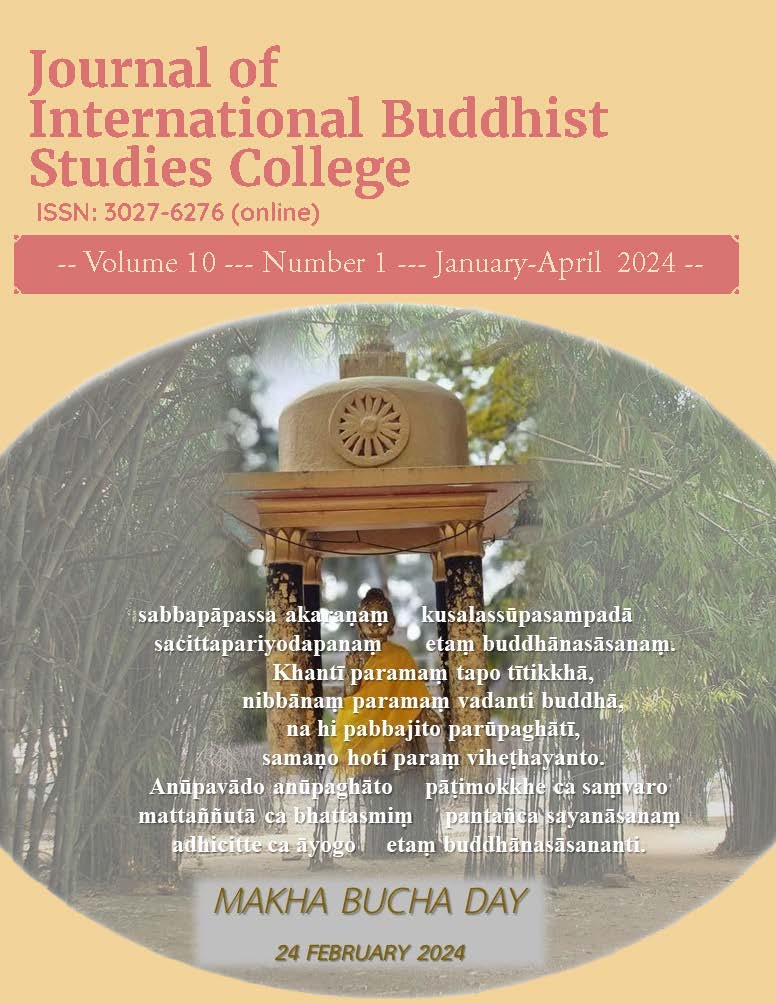Synergizing SDG's Focus on Quality Education with Buddhist Principles to Reduce Communication Apprehension in 21st Century Learners
Main Article Content
Abstract
This study explores the integration of Buddhist principles with Sustainable Development Goal (SDG) 4's focus on quality education to address communication apprehension in 21st-century learners. Effective communication skills are crucial for personal, academic, and professional success, yet anxiety associated with communication often hinders learning outcomes. By synergizing Buddhist teachings, which emphasize mindfulness and compassion, with SDG 4's objectives, educators can create inclusive learning environments that empower students to overcome communication barriers and foster holistic development. Mindfulness practices, such as meditation and breathing exercises rooted in Buddhist principles, have been shown to reduce anxiety and enhance communication skills. Additionally, incorporating cognitive-behavioral therapy principles can challenge negative beliefs about communication and promote confidence. This integration improves communication skills and nurtures emotional intelligence, empathy, and resilience, creating a positive and supportive learning environment. Meditation, as a core Buddhist practice, cultivates mindfulness and emotional regulation, helping students manage stress, focus better, and communicate more effectively, which is aligned with the SDG 4 goal of providing inclusive, equitable quality education by enhancing students' ability to learn and engage fully. On the other hand, meditation also supports SDG 4 by equipping learners with essential life skills, such as concentration, self-awareness, and emotional intelligence, which are vital for academic success and personal development. By fostering these skills, educators help students overcome communication apprehension, a common barrier to participation and success in educational and professional settings. Therefore, integrating meditation into education directly addresses SDG 4 by promoting well-rounded development, reducing barriers to effective communication, and ensuring that all students are prepared for active participation in society and the global workforce. This approach ensures that education imparts knowledge and builds the inner resilience needed to thrive in diverse and challenging environments.
Article Details
The Journal of TCI is licensed under a Creative Commons Attribution-NonCommercial-NoDerivatives 4.0 International (CC BY-NC-ND 4.0) licence unless otherwise stated. Please read our Policies page for more information on Open Access, copyright and permissions.
References
Berger, B. A., & McCroskey, J. C. (1982). Reducing communication apprehension in pharmacy students. American Journal of Pharmaceutical Education, 46(2), 132-136.
Brundtland, G. (1998). Report of the World Commission on Environment and Development (WCED). https://sustainabledevelopment.un.org/content/documents/5987our-common-future.pdf
Chansomsak, S., & Vale, B. (2008). The Buddhist approach to education: An alternative approach for sustainable education. Asia Pacific Journal of Education, 28(1), 35-50. https://doi.org/10.1080/02188790701850063
Chiesa, A. (2009). Zen meditation: An integration of current evidence. The Journal of Alternative and Complementary Medicine, 15(5), 585-592.
Erford, B. T. (2015). 40 techniques every counselor should know. Pearson Higher Ed.
Gardner, C. T., Milne, M. J., Stringer, C. P., & Whiting, R. H. (2005). Oral and written communication apprehension in accounting students: Curriculum impacts and impacts on academic performance. Accounting education, 14(3), 313-336.
Kittiprapas, S. (2022). Buddhist Sustainable Development: Inner Happiness as a Direction for Sustainable Development. Linking Sustainability and Happiness: Theoretical and Applied Perspectives, 45-63.
Levine, M. (2009). The Positive Psychology of Buddhism and Yoga: Paths to A Mature Happiness (2nd ed.). Routledge. https://doi.org/10.4324/9780203843116
McCroskey, J. C. (1984). The communication apprehension perspective. In J. A. Daly, & J. C. McCroskey (Eds.), Avoiding communication: Shyness, reticence, and communication, (pp. 13-38). SAGE Publications.
McCroskey, J. C. (1992). Reliability and validity of the PRCA-24: A brief measure of communication apprehension. Communication Quarterly, 40(4).
Nemati, A., & Razavieh, A. (2012). Developing global citizens: Service-learning and intercultural competence. Journal of Studies in International Education, 16(4).
Pavlina, S. (2014). Collaborative learning: Techniques and applications in business education. Journal of Management Education, 38(3).
Piyarathana, M. (2017). Share the vision on Buddhist philosophy of education. Asia Pacific Journal of Contemporary Education and Communication Technology, 3(2). https://apiar.org.au/journal-paper/share-the-vision-on-buddhist-philosophy-of-education/
Spowart, S. A. (2014). Long-term mindfulness meditation: Anxiety, depression, stress, and pain, is there a connection for public health? University of South Florida. https://digitalcommons.usf.edu/cgi/viewcontent.cgi?article=6326&context=etd
Srivichai, S. (2004, May). Buddhism and education. Paper presented at the International Conference on Theravada and Mahayana Buddhism: United Nations Day of Vesak.
United Nations Millenium Decleration, 2000). The Communication Apprehension in Students Who Are Working on Thesis. Jurnal Psikologi Teori Dan Terapan, 14(03), 270–278. https://doi.org/10.26740/jptt.v14n03.p270-280
Unterhalter, E. (2019). The many meanings of quality education: Politics of targets and indicators in SDG 4. Global Policy, 10, 39-51. https://doi.org/10.1111/1758-5899.12591
Young, T., Hazarika, D., Poria, S., & Cambria, E. (2018). Recent trends in deep learning based natural language processing. ieee Computational intelligenCe magazine, 13(3), 55-75.


